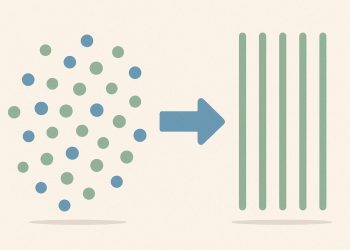Diffusion language models (DLMs) are a new way to build language AI that cleans up noisy text, instead of guessing words one by one. DLMs can learn more from less data, making them super helpful now that good internet text is getting scarce. They can fill in missing pieces in code, search long documents better, and create text using both left and right context at once. DLMs also work faster in some cases and are already being tried in code editors and legal templates. As data becomes harder to find, DLMs may soon outshine traditional models for many tasks.
What are diffusion language models and how do they compare to traditional autoregressive LLMs?
Diffusion language models (DLMs) are a new approach to large language models that use a progressive denoising process instead of left-to-right prediction. DLMs achieve similar or better performance than autoregressive models while requiring far less training data, offering data efficiency and strong results on long-document retrieval and code infilling tasks.
- Diffusion Language Models: The data-efficient challenger to autoregressive giants*
A wave of 2025 research shows that diffusion-based language models (DLMs) can match or even outperform traditional autoregressive (AR) large language models while using far less training data – a finding that could reshape how tomorrow’s LLMs are built.
Why data efficiency matters now
-
The internet is running out of ready-to-use text. Multiple surveys and Stanford-led studies indicate that most high-quality web text has already been consumed by existing models, making every additional token increasingly costly to acquire. Against this backdrop, DLMs offer a bidirectional training signal that extracts more learning from each sentence* than the next-token prediction used by AR models.
-
Key efficiency gains observed in 2025*
- <200 billion tokens: Apple researchers converted GPT-2 and LLaMA checkpoints (127 M–7 B params) into competitive DLMs using under 200 billion tokens – training budgets that are an order of magnitude smaller than frontier AR models.
- 20 % boost on long-document retrieval: A May 2025 arXiv paper found that diffusion-based text embeddings outperform AR counterparts by roughly 20 % on long-document search tasks, thanks to bidirectional attention capturing global context source.
| Task | Best paradigm (2025) | Evidence |
|---|---|---|
| Language-model perplexity | AR still leads; diffusion narrows gap | LLaDA-8 B approaches LLaMA-3 8 B scores [ICLR 2025] |
| Reversal-curse robustness | DLM shows advantage | LLaDA surpasses GPT-4o on reversal-poem completion |
| Code infilling / FIM | DLM preferred | Bidirectional generation enables gap-filling without prompt tricks |
How DLMs work – and why they scale differently
Unlike AR models that predict the next token left-to-right, DLMs learn by progressive denoising: they repeatedly refine a noisy text vector until it matches the target sequence. This gives two practical advantages:
- Parallel token generation – large chunks of text can be produced simultaneously, slashing latency for long outputs.
- Bidirectional context – every token sees both left and right surroundings, boosting sample efficiency and controllability.
Recent techniques such as energy-based diffusion (EDLM) from NVIDIA reduce the number of required denoising steps by ~30 % while reaching AR-level perplexity, addressing the classic speed concern of diffusion sampling source.
Real-world deployments – where DLMs are already useful
While still early, pilot integrations hint at high-value niches:
- Code editors: Apple’s DiffuGPT fills in the middle of functions without prompt re-ordering, enabling seamless refactoring.
- Legal & medical templates: Bidirectional conditioning aligns generated text with strict left-right constraints, reducing hallucinations in high-stakes documents.
- Retrieval-augmented systems: Long-context embeddings powered by DLMs improve recall accuracy, a direct benefit for enterprise search tools.
Current limitations include inference latency (multi-step sampling vs. single-pass AR) and context-length ingestion, both active areas of hardware and algorithmic optimization.
Outlook for 2025–2026
The convergence of data scarcity and proven data-efficiency gains is pushing more labs to allocate compute budgets toward diffusion or hybrid architectures. Expect head-to-head scaling curves between DLMs and AR models on standardized corpora within months, with early results pointing to DLMs as the go-to choice when high-quality data is the bottleneck rather than raw compute.
How do Diffusion Language Models (DLMs) differ from traditional autoregressive LLMs?
DLMs learn by denoising corrupted text in a bidirectional manner, whereas AR models predict the next token left-to-right.
This difference gives DLMs richer training signals per token and enables parallel block generation, making them more data-efficient. Recent Apple research shows that converting an existing AR backbone into a DLM needs < 200 B tokens to reach competitive quality – far fewer than training a new AR model from scratch.
Why does data efficiency matter more than ever?
- High-quality web text is nearly exhausted. Industry surveys note that most readily available, high-quality internet text has already been consumed by 2025 models.
- Synthetic data pipelines are still nascent, so sample-efficiency gains directly translate to lower cost and faster iteration.
- Microsoft’s new DELT framework shows that smarter data ordering alone can lift model performance without adding a single extra token – a complementary lever to DLM efficiency.
What tasks already favor DLMs over AR models?
| Task | DLM advantage | Verified result |
|---|---|---|
| Long-document retrieval | Bidirectional attention boosts 20 % higher recall | arXiv May 2025 study |
| Code infilling (FIM) | Parallel denoising fills gaps without prompt re-ordering | Apple DiffuLLaMA-7B |
| Reversal reasoning | Beats GPT-4o on reversal poem completion | ICLR 2025 LLaDA-8B |
When will DLMs move from labs to production?
- 2025–2026 pilots are emerging for controllable generation and structured editing (e.g., legal templates, API schema adherence).
- Real-time chat remains AR-led due to latency; DLMs still need 1.3–2× more sampling steps.
- Industry experts expect selective adoption: specialized copilots, tool-augmented assistants, and safety-critical pipelines that benefit from bidirectional context and iterative refinement.
Key takeaway
DLMs are no longer theoretical. Empirical results show they can rival AR models with less data and excel in editing, retrieval, and constrained generation. If data scarcity continues to bite, expect DLMs to shift from research curiosity to strategic component in the next wave of LLM stacks.



















